Sam Kerr’s legend began with an underground, after-school football bootcamp at a Perth park
It might have looked like a bunch of kids mucking around but to one keen observer, it was the future. Since age 12, the talent of Matildas World Cup megastar Sam Kerr has been astonishing, writes ELIZA REILLY.

World Cup
Don't miss out on the headlines from World Cup. Followed categories will be added to My News.
To the casual observer, it looked like a bunch of kids mucking around a tree-lined park near busy Spearwood Avenue.
To Alistair Edwards, it looked like the future.
There was his son Ryan, now playing for SD Amorebieta in Spain. There was 112-game Perth Glory midfielder Shannon May. There was future W-League premiership player and Perth Glory golden boot Marianna Tabain. There was Glory journeywoman and Australian international Ella Mastrantonio.
And there was Sam Kerr.
That underground, after-school football bootcamp at Beale Park in Cockburn was where the legend started. And it was clear to those who observed those sessions first-hand that Kerr was going to become one.
“There were maybe four or five of them but it was an open group that anyone could join,” Edwards, one of Kerr’s founding mentors, recalled. “I knew they had to be training at a certain level but they were only getting two sessions in a week with their clubs. So we started doing bonus sessions after school every other night.”
When Edwards first laid eyes on Kerr, then a 12-year-old playing for the Western Knights, he was stunned. Kerr had the sort of skillset to excel in any sport. He just had to ensure that sport was football.
“She was better than the boys,” Edwards recalled. “She was faster than them. She had an amazing, vertical leap and this attitude that nothing was impossible. She’d get the ball, dribble past people and score goals. And she did it all with a smile on her face.”

Footy versus football
Edwards had only recently retired from the Perth Glory when he decided to establish a National Training Centre for would-be professional footballers in Western Australia. Every other state already had an established pathway for aspiring Matildas. Edwards, who himself was forced to leave Perth as a teenager to pursue football, recognised that WA was falling behind.
The NTC had been in operation for less than a year when Edwards spotted Kerr dancing through players at Len Packham reserve in Coolbellup. He approached the Kerr family with an offer that he thought was too good to refuse.
“‘Sam, do you want to come and join the National Training Centre program?’” he asked.
“She goes, ‘Nah, I’m OK.’”
Edwards wasn’t giving up without a fight.
Kerr was born into a sporting family so it seemed a forgone conclusion that she would follow an athletic path. Her grandfather was a featherweight boxer. Her mother Roxanne played basketball. Her father Roger played 125 games of state league football between East Fremantle, Perth and Port Adelaide. Her brother Daniel was in the early stages of a premiership-winning career at West Coast.
Kerr would probably have picked Australian Rules had the AFLW existed back in the early 2000s.
“I told her she could go and play netball but she’ll play against New Zealand and maybe England,” Edwards said. “There was no AFLW for her to play. She probably could’ve been an Olympian as well.
“But with football, there’s a lot of big plans. We had international tournaments in Asia she could play. We had national championships. There were countries around the world launching their own competitions. There was the potential to travel the world with the Matildas. The world was her oyster, so to speak.
“She’s the type of person that would’ve been a star in whatever sport she chose. Luckily for football, Sam chose to be a footballer.
“I’ve spoken to Roxanne since and we laugh about how everything I said in my pitch has actually happened.”
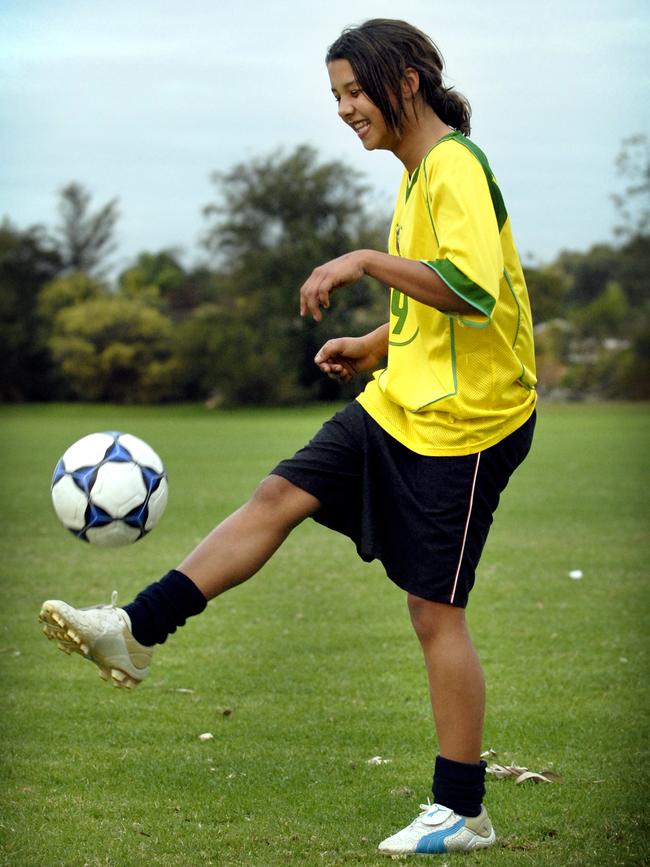
After some gentle persuasion, Kerr agreed to start at the National Training Centre, albeit sporadically. Every other aspiring Matilda trained full-time. But Edwards wasn’t about to risk losing his golden prodigy.
“She was happy at the Western Knights,” Edwards recalled. “We said it was fine if she wanted to stay with the Knights but she could drop in to us whenever she wanted.
“If we as a football program were strict and said, ‘No, you have to come to us and you can’t do this and that,’ we would’ve lost her.”
As the saying goes, you can’t be what you can’t see. And soon Kerr was surrounded by current and former professional footballers. Nicola Williams, Tanya Oxtoby and Jessine Bonzas were just some of the players that helped cultivate a high-performance environment for the kids coming through.
“(Sam) was really driven to improve and we wanted to support that by creating an elite environment,” he said. “I guess we fostered that desire within her.
“The fact we started the program just as she was coming through was a case of perfect timing. Otherwise, there wouldn’t have been a pathway for her.
“The biggest thing, if anything, I can take credit for is helping Sam choose football.”
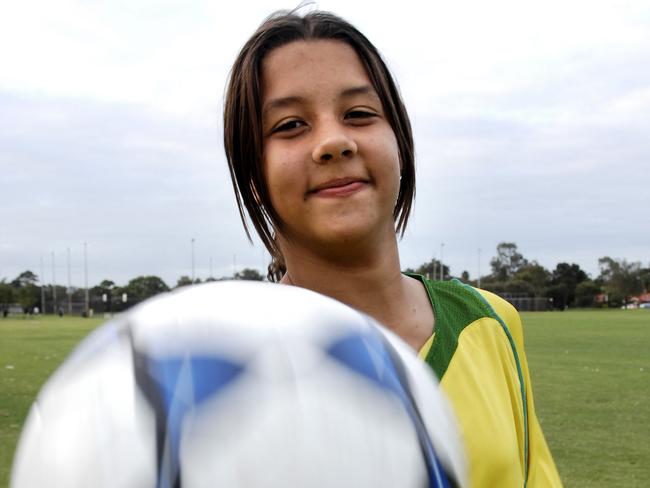
‘X’ before the backflip
Kerr was hooked. She soon committed to joining the NTC full-time and the door flung open to a new world of opportunity.
She joined WA’s state under-14s program and was selected to embark on a regional tour of the state towards Albany in the south west soon after.
Bonzas, one of Kerr’s first state level coaches, was blown away.
“Dynamic. She had x-factor. She was athletic. There was a lot of raw talent,” Bonzas said. “There are players who can read the game and be in the right place at the right time. Some of that you can’t actually coach. She was heads above her peers at that stage.”
It wasn’t the first time Bonzas had witnessed Kerr in action.
She just had to connect the dots.
“I was a teacher at the time as well and I remember playing against her,” she said. “She would just tear us apart.”
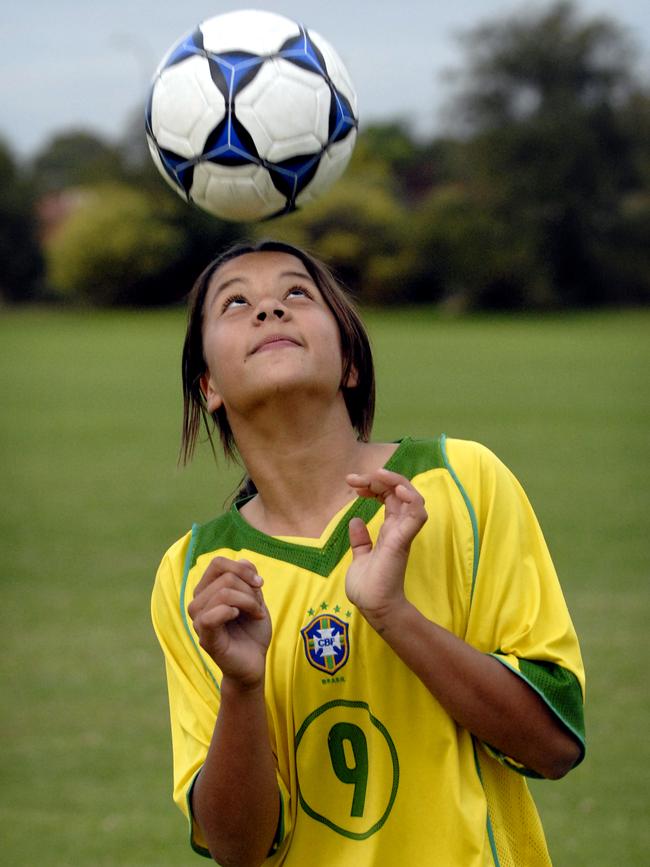
The following year, 2006, the team travelled to Coffs Harbour for the Under-15 National Championships. Kerr was an entire two years younger than her peers.
Western Australia had notoriously struggled to compete with the likes of Queensland, New South Wales and Melbourne. That changed when Kerr joined the team.
WA finished second overall and Kerr scored her state’s only goal in a 2-1 loss to Queensland in the final, initially putting the game into extra time. Matildas coach Tom Sermanni was a keen observer.
“I can vividly remember it. It was freezing cold in the middle of winter. But she’s just dribbling down a wing, miles ahead of anyone else. She’s kicking goals when you think she’s not even going to make it to the ball,” Bonzas recalled.
“There were definitely early glimpses of her being a superstar. Can you ever predict it? You’re probably not thinking that far ahead. But you could see she was an outstanding player.”
Added Edwards: “When the players are that young, it’s hard to tell whether they’ll progress. Some have good skill level and technique. But the ones like Sam, you could tell.
“She had so many incredible athletic attributes,” he continued. “We knew that if we could refine that with her technical ability, she would go far.”
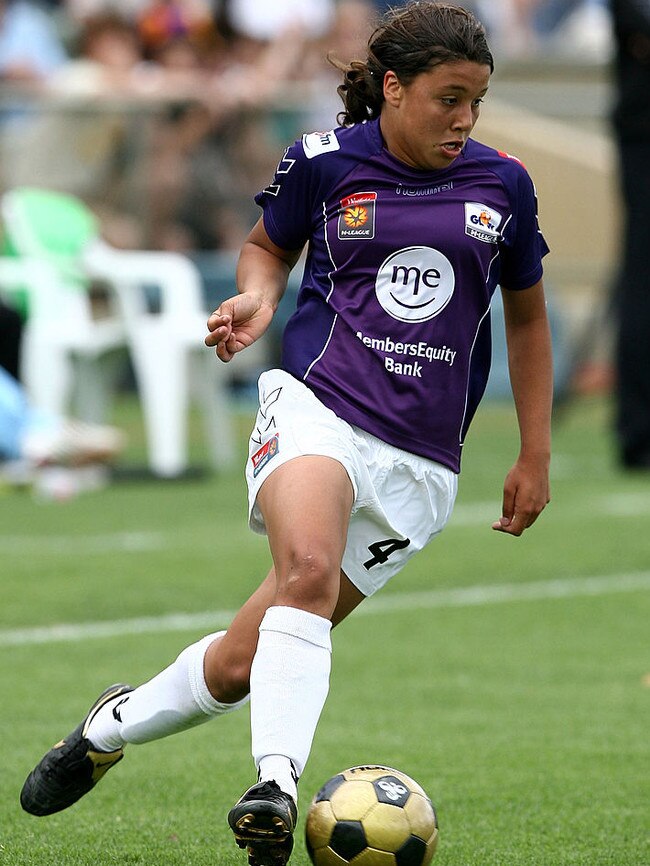
That next level was the W-League.
Having witnessed what Kerr was capable of at the NTC, Western Waves alumni and inaugural Perth Glory coach Williams selected Kerr in her maiden squad ahead of the 2008 season.
It took just 36 minutes into Perth’s first game for a 15 year-old Kerr to get an opportunity off the bench. She started every game after that and scored the first of 95 W-League goals in her fifth outing.
“She sort of put her hands across her chest and made a ‘X’ with them because she was our X-factor. That was long before the backflip,” Williams said.
“It was like she was elastic. She’d jump higher than everyone else. She’d jump around the pitch. It was almost better when the ball bounced up because she’d be the first to reach it.”
Parts of the Kerr canvas were already filled in.
But there was one glaring deficiency.
“Her technique was one of the areas that was most lacking at that point,” Williams said. “She could dribble and get the ball into space. It was more her control, finishing and scoring elaborate goals. That was something she had to work on a lot.”
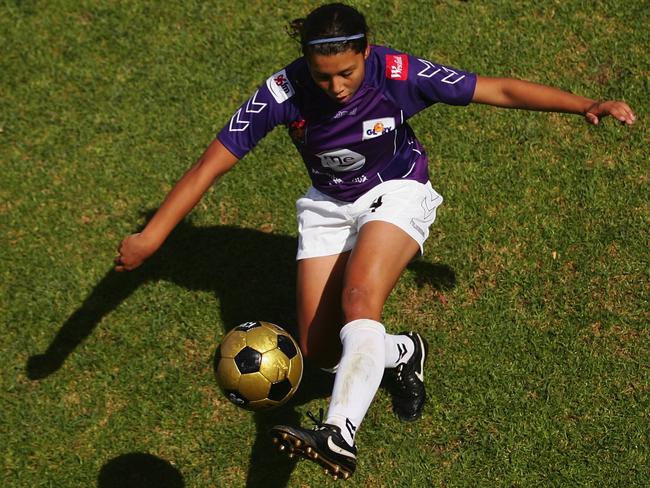
Epiphany in the Kimberley
Williams was replaced as head coach by John Gibson after just one season. Despite still balancing international commitments, Kerr won the Player’s Player of the Year and Goal of the Year at the 2009W-League Awards. She also made her international debut, coming off the bench in the 76th minute of a 5-1 friendly loss to Italy.
Perth Glory games record holder Jamie Harnwell took over as manager in 2011 just months after retiring as a player. Harnwell said it was “devastating” to learn Kerr was headed to Sydney FC in preparation for a move to the US. But when she did return to Perth three years later, she brought the band with her.
Thanks largely to Kerr’s powers of persuasion, fellow Matildas Alanna Kennedy, Caitlin Foord and Mackenzie Arnold headed west as well. Add in the likes of Kate Gill and Collette McCallum and Harnwell suddenly had a true purple army.
“The team that season was the strongest I’d been involved with,” Harnwell said of his 2014 roster. “We thought we could do something special that season.”
Kerr’s first commitment was a training camp in Broome shortly after returning from the United States, where she had led the Western New York Flash with nine goals in 20 games. It was up in the Kimberley that Harnwell and Kerr started thrashing out her role in the team.
Until then, Kerr had mostly played as a winger.
Harnwell was eager to inject some more power up front.
“My intent was always to play her as a centre forward alongside Kate Gill. The way I wanted to play required two centre forwards and Sam was naturally suited to that,” Harnwell said.
“It was a dual strike force combining Kate’s ability to hold the ball up and her strength in the air with Sam’s speed and ability to get on the end of things. It was unique and potent.
“She’d played there before so I didn’t come up with the idea. But ultimately I wanted a goal scorer. I thought Sam would be much more effective centrally than she would be as a winger.”

Kerr netted 11 goals that season and Gill scored 15. In one 10-1 thrashing of the Western Sydney Wanderers, they kicked goals seven between them.
“They were incredible,” Harnwell reflected.
“As soon as there was any ball played over the top, you knew you were half a chance of scoring if Sam was in the area. She could give a defender a five metre head start and usually still catch them and beat them.
“Kate Gill was an absolute professional. She’d do so much work on her finishing and I think that rubbed off on Sam because her finishing certainly has improved as well.”
The Glory wrapped up the 2014 W-League premiership in record time with a 10-2 record. But two weeks before the grand final, disaster struck.
Shortly after putting the premiers ahead in their round 12 clash with Canberra United, Kerr suffered a serious knee injury that ruled her out for the rest of the season. Perth would lose the grand final 3-1 to Canberra in her absence.
“The disappointment on her face was as if she’d played,” Harnwell said. “She was on crutches at that point and looked as though she was trying to kick every ball from the grandstand for the entire 90 minutes.”
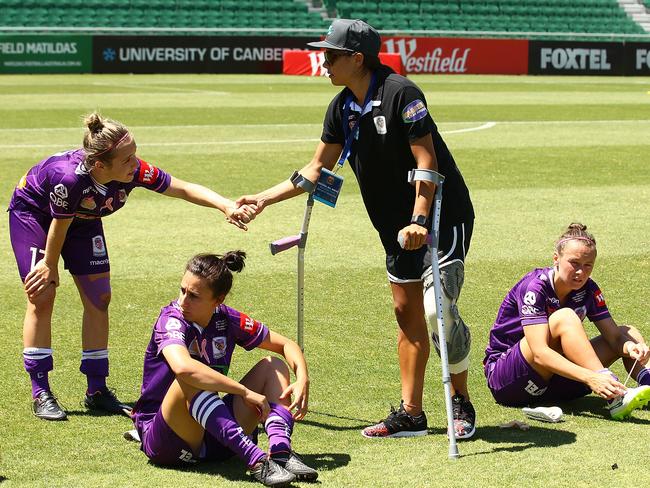
Kardinya to the world
From that season of heartache has sprung an unprecedented near-decade of success.
Kerr has won Super League titles, FA Cups and a medal of the Order of Australia. She is a Julie Dolan medallist, a four-time nominee for the Ballon d’Or and a golden boot on three different continents.
But if you ask those who know her best, worldwide fame and acclaim has done little to change the outlook and perspective of the kid from Kardinya.
“Sam Kerr is a superstar, but she hasn’t changed,” Edwards said.
“She was a breath of fresh air every time she walked into a room. She had this confidence about her, even when she was 12-years-old. Women’s football has grown around the world and Sam has been synonymous with that growth.”

Bonzas concurs. “I remember her as a kid on tour playing little pranks with her friends … all in good spirit. If she came into the change rooms, everyone would light up because she’s so charismatic. Everyone wants to hang out with her, share a story with her, have a joke with her.
“Some of the things I saw in her as a 12, 13, 14 year old were still beautiful qualities that she presented as a leader when she captained the Perth Glory a few years down the track.
“She nurtured the younger players that came through the Glory. She took them under her wing and gave them so much advice.
“She believed in them so they could believe in themselves.”
Wherever Kerr has gone, success has followed. And now the ultimate prize is on offer, on home soil.
Originally published as Sam Kerr’s legend began with an underground, after-school football bootcamp at a Perth park




